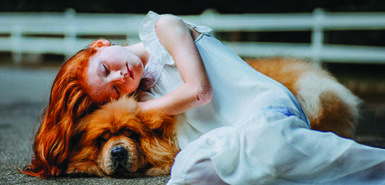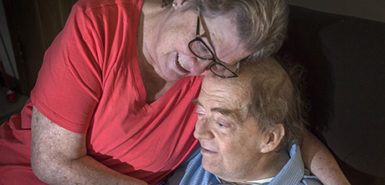
It seems everywhere we go—to the dentist, the chiropractor, the emergency room and even the airport—we’re getting scanned.
And what if we’re unfortunate enough to be battling cancer and add radiation treatments on top of everything else?
Is there a limit to how much our bodies can take? Should we decline some requests for scans?
Evan Boote, PhD, radiation safety officer for Spectrum Health, said it’s important to keep things in perspective. Just by living and breathing on this earth, we’re exposed to inevitable radiation known as “background radiation.”
“We live in an environment where there is radiation around us all the time,” Boote said. “The primary source is cosmic radiation, radiation from the sun and radiation from space that reaches the earth.”
Radiation above, and radiation below.
“There are radioactive materials in the soil,” he said. “There are radioactive isotopes in the foods we eat. One of the sources people are tuned into is radon, which is a gas. That counts for almost half of what we get each year. Radon is a daughter product of radium. It’s in the soil. The gas will come through the cracks in our basement. It’s hard to detect. It’s a potential cancer-of-the-lung producing agent.”
According to research, background radiation exposure equates to 2 to 3 millisieverts per year for each of us (don’t trip on the term, it’s a fancy word used to measure radiation exposure).
Worried about getting a chest X-ray? It adds the equivalent of five days of background radiation. And dental X-rays? Only a fraction of that. Think hours. Watching-a-football-game kind of hours.
“It’s like living through a leap year,” Boote said of dental X-rays.
A skull X-ray adds about three weeks of background radiation. Abdominal X-rays, five weeks worth.
Your trip through the airport scanner? Not enough radiation to even mention, according to Boote. But if you’re a frequent flier and spend a lot of time in the friendly skies? That’s where you get dinged.
“If you live at high altitudes or if you fly a lot, you’ll get exposed to more radiation because there’s not as much atmosphere above you to block radiation,” Boote said. “An international flight is the approximate equivalent of a chest X-ray. Every 90 minutes of flight is about the same as a dental X-ray.”
Flight crews absorb more than double the annual radiation of the average population.
Ask questions and stay informed, but remember that the benefits of an X-ray or treatment for cancer will likely be much greater than the risk, and it could save your life.
But for most people with two feet on the ground most of the time, imaging radiation doses are generally considered safe.
CT scans emit the largest dose of radiation; X-rays, 10 to 100 time less.
“It depends on the body part that’s being imaged,” Boote said. “If you’re taking an X-ray of the hand, you’re not exposing critical organs to radiation.”
Radiation exposure can cause cancer, but it’s nothing to stay up at night worrying about.
“It’s kind of an unknown how much we can safely get over a lifetime,” he said. “The rule of thumb we use is that if you expose 1,000 individuals to 10 mSv of radiation, one will develop cancer. Roughly 420 of those 1,000 will develop cancer without any medical radiation exposure.”
In other words, 420 were genetically or otherwise predisposed to cancer.
Boote said technology is also working in everyone’s favor to minimize radiation risk.
Over the last decade CT scanners have been designed to use less radiation while still producing quality images.
“Compared to CT scanning in the 1990s and early 2000s, today’s models of CT scanners are delivering 25 to 40 percent less radiation,” Boote said.
At Spectrum Health Helen DeVos Children’s Hospital, where pediatric radiation exposure can be of greater consequence than in the adult world, special protocols are in place to keep radiation doses as low as possible.
“We know that for children and young people it’s a greater risk of cancer, but that risk decreases by the time somebody is 30 or 40 years of age,” Boote said. “We’re really sensitive to limiting radiation and X-ray exposure to kids under 20 years of age.”
Boote said if you have concerns, for a child or adult, ask questions of the physician ordering the scan.
Ask if there’s a quality alternative.
But keep in mind a scan can often illuminate problems that are more dangerous than the scan itself.
Cancer discovered early by a scan may be curable. Undiscovered, it may be fatal.
“Sometimes the risk of not knowing what is going on in patients is more harmful than the potential risk of radiation exposure,” Boote said. “We don’t do exploratory surgery anymore. We do a CT scan. I’d much rather have a CT scan than have a surgeon open me up. There’s a lot more risk associated with that than there is a CT scan. It’s all in putting the risk in context and looking at the benefit of the study in proper context as well.”
Judy Smith, MD, chief of the Spectrum Health Cancer Center, said radiation, whether from imaging or cancer therapy, can save your life.
“But we are always working to decrease the amount of radiation required,” Dr. Smith said. “In the United States, much of our testing is now done with digital technology and this significantly lowers the amount of radiation used.”
Better technology, such as 3-D mammograms, decreases the “call back” rate and need for further imaging, according to Dr. Smith.
Cancer physicians and patients have participated in dozens of clinical trials to evaluate “shorter course” radiation and found it to be highly effective in some cancer situations, according to Dr. Smith. For instance, the Spectrum Health Cancer Center also offers SABRE Radiosurgery, which delivers a targeted beam of radiation in just a few sessions, targeting cancer while avoiding other tissue.
Dr. Smith said the best precaution against excessive radiation is to be an informed patient.
“I recommend that you always make sure you understand why a test or treatment is being performed,” she said. “Ask questions and stay informed, but remember that the benefits of an X-ray or treatment for cancer will likely be much greater than the risk, and it could save your life.”
 /a>
/a>
 /a>
/a>
 /a>
/a>